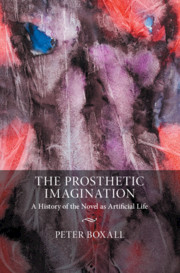Book contents
- The Prosthetic Imagination
- The Prosthetic Imagination
- Copyright page
- Dedication
- Epigraph
- Contents
- Illustrations
- Acknowledgements
- Introduction
- Part I The Body and the Early Modern State: From More to Cavendish
- Part II The Colonial Body: From Behn to Goethe
- Part III The Manufactured Body: From Wollstonecraft to Stoker
- Part IV The Modernist Body: From James to Beckett
- Part V The Posthuman Body: From Orwell to Atwood
- Chapter 8 Prosthetics and Simulacra: The Postmodern Novel
- Chapter 9 Prosthetic Worlds in the Twenty-First-Century Novel
- Notes
- Bibliography
- Index
Chapter 9 - Prosthetic Worlds in the Twenty-First-Century Novel
from Part V - The Posthuman Body: From Orwell to Atwood
Published online by Cambridge University Press: 18 September 2020
- The Prosthetic Imagination
- The Prosthetic Imagination
- Copyright page
- Dedication
- Epigraph
- Contents
- Illustrations
- Acknowledgements
- Introduction
- Part I The Body and the Early Modern State: From More to Cavendish
- Part II The Colonial Body: From Behn to Goethe
- Part III The Manufactured Body: From Wollstonecraft to Stoker
- Part IV The Modernist Body: From James to Beckett
- Part V The Posthuman Body: From Orwell to Atwood
- Chapter 8 Prosthetics and Simulacra: The Postmodern Novel
- Chapter 9 Prosthetic Worlds in the Twenty-First-Century Novel
- Notes
- Bibliography
- Index
Summary
This chapter focuses on the novel of the twenty-first century to suggest that we are seeing now a new way of understanding the forms in which the novel pictures the world. The chapter opens with an exploration of the terms in which climate change and advances in the medical creation of artificial life have together shifted our understanding of the relationship between nature and culture. In light of Dipesh Chakrabarty’s argument that the eco-crisis sees the collapse of culture into nature, the chapter suggests that the contemporary novel is involved in the picturing of a world that becomes thinkable when the opposition between nature and culture has been overcome. It then goes on to read this new kind of world picturing, as it comes to expression in twenty-first-century novels by three of the major writers of the contemporary novel – Margaret Atwood, J. M. Coetzee and Don DeLillo. It is possible to see in these writers, the chapter argues, the culmination of the prosthetic imagination as I have traced it through the history of the novel, a culmination in which the capacity to picture the world is won from the novel’s intimacy with the resistance of our bodies and environments to the forms in which we seek to make them imaginable and habitable.
Keywords
- Type
- Chapter
- Information
- The Prosthetic ImaginationA History of the Novel as Artificial Life, pp. 319 - 354Publisher: Cambridge University PressPrint publication year: 2020

